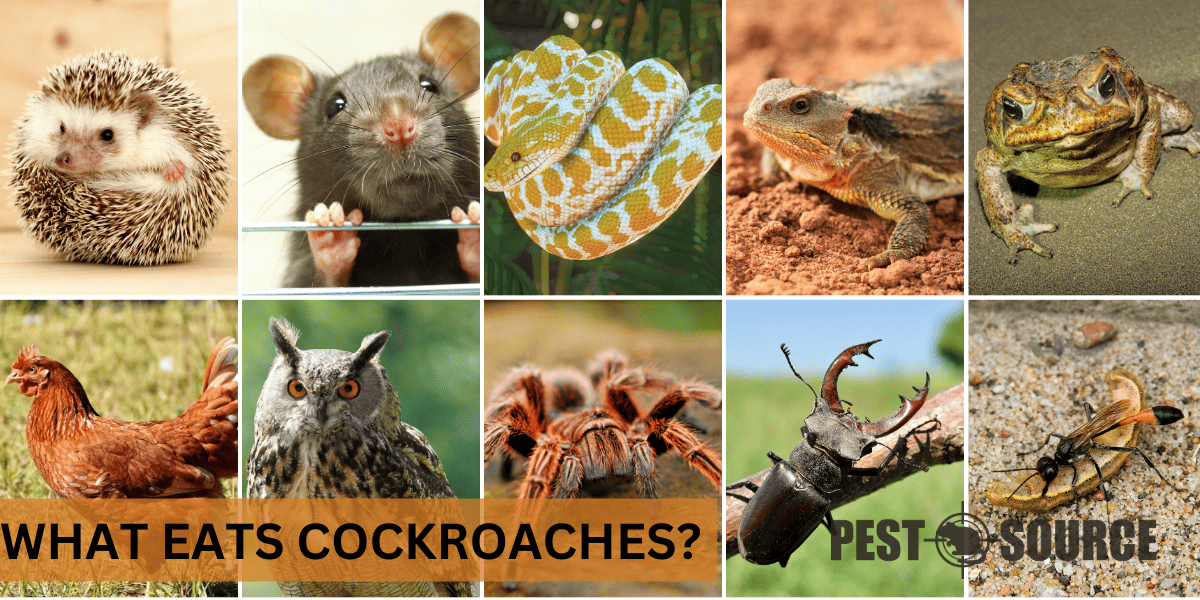Natural predators of cockroaches include birds, mammals, amphibians, and other insects like centipedes. This article discusses the role of these predators in controlling cockroach populations.
POINTS
- Predators of cockroaches include birds, mammals, reptiles, amphibians, and other insects, which help control cockroach populations naturally.
- The presence of predators influences cockroach behavior and adaptations, leading to changes in their foraging habits and increased nocturnal activity.
- Regional and species-specific variations in predators lead to different dynamics in predator-prey interactions, affecting cockroach populations in various environments.
- Ecological balance is maintained by predators, which helps prevent cockroach overpopulation and the potential spread of diseases.
- Lesser-known predators like centipedes, nematodes, and bats also play a role in controlling cockroach populations and contribute to ecosystem stability.
Overview of Cockroach Predators
Cockroaches are notorious for their resilience and ability to thrive in various environments, but they are not invincible. In the natural world, they play a role in the food chain, serving as prey for a diverse array of predators. Understanding what animals and insects prey on cockroaches is essential for appreciating the ecological balance and the potential for natural pest control.
Predators of cockroaches include a wide range of creatures, from birds to ants, and even certain household pets. The presence of these predators can significantly impact cockroach populations, helping to keep their numbers in check. This natural form of pest control is crucial in maintaining ecological stability and can reduce the need for chemical interventions.
Specific Animals and Insects That Prey on Cockroaches
Cockroaches, while often seen as pests, play a role as a food source in the ecosystem. Many animals have adapted to include these insects in their diet. Here’s a closer look at the various creatures that help keep cockroach populations under control:
Mammals
- Hedgehogs: These small, nocturnal mammals have a diet that includes a variety of insects, with cockroaches being one of them. Hedgehogs are particularly effective in outdoor areas like gardens.
- Rats and Mice: Although not their first choice, these omnivorous rodents will consume cockroaches when available. They tend to target a range of pests, including flies and mosquitoes.
Birds
- Chickens: As omnivores, chickens will readily eat cockroaches, which makes them useful for pest control in agricultural settings like poultry houses.
- Wild Birds: Owls, hawks, and crows are among the wild bird species that prey on cockroaches, helping to manage their populations in various environments.
Reptiles
- Lizards: Lizards, including geckos, skinks, and iguanas, are well-known predators of cockroaches and can be quite efficient in controlling their numbers.
- Snakes: Certain snakes, such as the rough green snake and the ringneck snake, also include cockroaches in their diet, especially in outdoor spaces like gardens.
Amphibians
- Toads and Frogs: These amphibians consume cockroaches and are particularly adept at controlling their populations in damp habitats.
Other Insects
- Spiders: Wolf spiders and jumping spiders are examples of arachnids that will hunt and eat cockroaches.
- Beetles: Ground beetles and rove beetles are among the beetle species that prey on cockroaches.
- Wasps: Some parasitic wasps lay their eggs inside cockroach egg cases. When the wasp larvae hatch, they eat the cockroach eggs from the inside out. These wasps can be effective at controlling cockroach populations.
In urban environments, the role of these predators can be particularly significant as they adapt to living alongside humans and help control pest populations.
However, while these predators can help manage cockroach populations, they may not be sufficient to control an infestation in a home. If you’re facing a cockroach problem, it’s advisable to seek the expertise of a professional pest control service to effectively eliminate them.
Regional and Species-Specific Variations in Cockroach Predators
The predators that prey on cockroaches can vary widely depending on the region. For instance, in Florida, the American cockroach may fall victim to the invasive Cuban tree frog, while in California, the common ensign wasp is known to parasitize cockroach eggs, helping to reduce future populations of these pests.
Different cockroach species also attract specific predators. The German cockroach, for example, is small and fast, making it a challenging target for some predators but an ideal prey for others, such as centipedes. These predator-prey interactions are influenced by the behaviors and adaptations of both the cockroaches and their hunters, leading to a dynamic balance that can differ from one environment to the next.
Ecological Impact of Predator-Prey Relationships on Cockroach Populations
The interplay between predators and cockroaches is a fundamental aspect of the ecosystem. Predators exert a controlling influence on cockroach populations, which in turn affects the behavior and evolution of these pests. Let’s delve into the ecological impact of these relationships.
Natural Pest Control
Predators act as natural pest controllers by hunting and feeding on cockroaches. In environments where predator species are abundant and diverse, cockroach populations are kept in check, reducing the likelihood of infestations. This balance is crucial for preventing cockroaches from becoming overpopulated, which can lead to increased competition for resources and potential spread of diseases.
Behavioral Adaptations
The presence of predators forces cockroaches to adapt in order to survive. These adaptations may include changes in foraging habits, increased nocturnal activity, and the development of evasion techniques. Such behaviors make cockroaches less visible and less susceptible to predation, but they can also influence the cockroaches’ ability to compete for food and mates, ultimately shaping their population dynamics.
Ecosystem Stability
Predators contribute to the stability of ecosystems by maintaining the balance between different species populations. Without predators, cockroach populations could explode, leading to ecological imbalances where these insects outcompete other species for resources. This could have a cascading effect on the food web, impacting not only the cockroaches but also other organisms that share their habitat.
Highlighting Unusual or Lesser-Known Predators
While birds, mammals, and reptiles are well-recognized as cockroach predators, there are also lesser-known creatures that play a significant role in controlling these pests:
- Centipedes: These multi-legged predators are efficient hunters of cockroaches, especially in damp environments where both species thrive.
- Nematodes: Certain species of these microscopic worms can infect and kill cockroaches, acting as biological control agents.
- Bats: In some regions, bats are known to consume insects, including cockroaches, as part of their diet, contributing to natural pest control.
These unusual predators, though not as commonly considered in pest control strategies, are integral to the ecological web and offer additional means of managing cockroach populations.
Do Mice Eat Cockroaches?
Yes, mice sometimes eat cockroaches, particularly in wild or feral environments. This opportunistic feeding behavior occurs mainly when other food sources are limited. Mice, primarily nocturnal creatures like cockroaches, may prey on them due to overlapping habitats and active periods. However, this is not a primary food source for mice and depends on factors like the availability of other nourishment, the environmental setting, and the specific characteristics of the mouse and cockroach populations.



